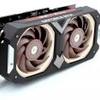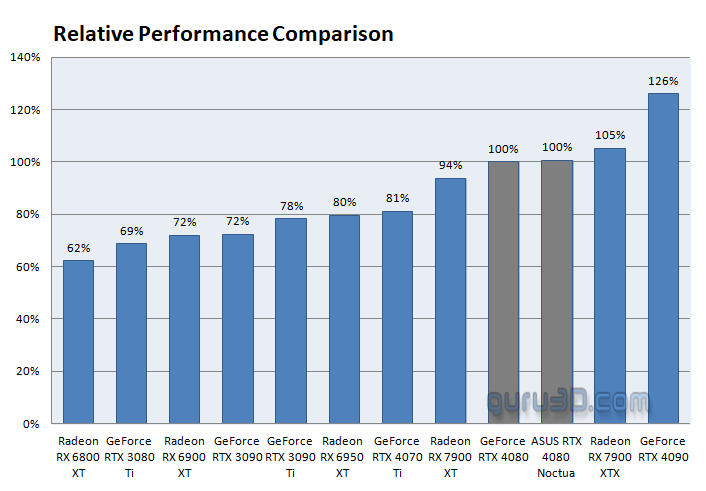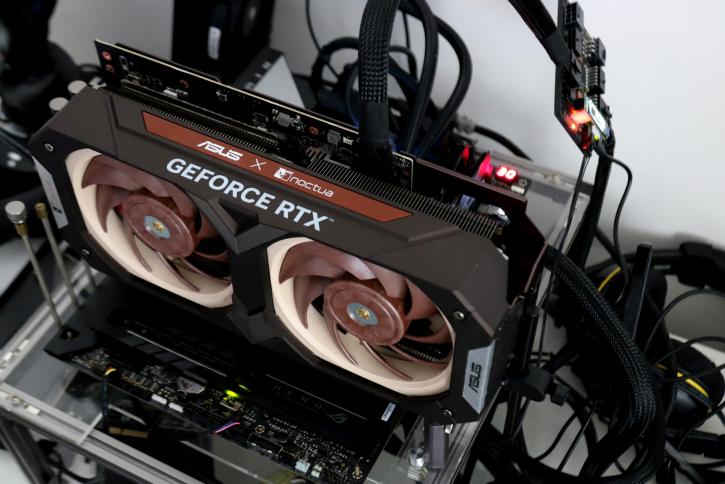Final words and conclusion
Final words
The ASUS GeForce RTX 4080 Noctua OC variant is an outstanding graphics card that performs its duties with great precision and efficiency. One of the most noteworthy features of this card is its quiet operation, which is achieved without the need for liquid cooling systems. While many people believe that the Noctua variant is exceptionally quiet, it's worth noting that other high-end graphics cards, such as the MSI TWiNFrozer and the ASUS STRIX, offer comparable levels of noise reduction. Despite this, the Noctua card's premium pricing is justified in its overall quality and brand reputation. In silent BIOS mode, the card operates at an almost inaudible level, and including a Noctua cooler has been a long-awaited addition for many gamers. However, it's worth noting that the card's 4-slot size may surprise some users who are used to smaller form factors. Regarding game performance, the Noctua OC variant delivers a modest 0~1% improvement over the founder edition in the most GPU-intensive situations. While it is true that the card's brown and beige color scheme may not appeal to everyone, but it doesn't detract from its impressive performance. One of the card's most convenient features is its dual BIOS, which provides a failsafe option as well as the ability to switch between silent and OC modes. However, the OC BIOS mode doesn't offer any significant performance gains, so it's recommended to stick to the default silent setting. NVIDIA is placing a significant emphasis on the use of DLSS, with the inclusion of vastly improved Tensor cores that aid in the new DLSS 3.0, which currently offers a 2x performance increase. With correct implementation in future games, NVIDIA claims a 3x or 4x performance boost is possible. However, there is ongoing debate about the value of frame injections beyond higher framerates. Ultimately, the visual quality displayed on the monitor is what counts, and in this regard, the GeForce RTX 4080 delivers. One obstacle that high-end graphics cards from NVIDIA face is pricing. Starting at $1299 and likely reaching prices of 1500 EUR, these cards are becoming increasingly unaffordable for most consumers. Additionally, the new power connector may raise concerns as bending the cable too close to the connector, combined with poor quality, can lead to hazardous situations. To avoid this, it is recommended to bend the cable 3-4cm above the connector level. Despite these concerns, all cards tested to date have been checked with FLIR imaging, and no issues have been observed on our side.
Performance
You've seen the numbers, and we've already let the cat out of the bag. It all comes down to gaming performance and, of course, rendering quality. Yes, the RTX 4080 provides more value for the money than seen from the 4090, as we're getting close to raw performance levels that easily enable gaming at 4K resolution. Most enthusiast gamers play at UWHD, QHD, or UHD monitor resolutions. This card is designed for precisely that kind of gamer.
The new rasterizer engine surpasses previous performance limitations through the utilization of 9K shading processors. The RTX 40 series boasts a new generation of ray tracing and Tensor cores that are more powerful than previous models. Despite a lower count of RT and Tensor cores, the overall performance of each unit is significantly improved due to their proximity to the shader engine. Tensor cores are difficult to measure, but initial observations indicate they are performing well, as demonstrated by the impressive results of DLSS3. In conclusion, the GeForce RTX 4080 is suitable for use at resolutions ranging from 2K (2560x1440) to 4K (3840x2160).
Cooling & noise levels
In summary, the graphics card operates in silent BIOS mode, producing a low noise level of 30~31 DBa, which is slightly above the lowest measurable level of 29-30 DBa. While the card's performance in performance mode is slightly better, it comes at the cost of slightly worsened acoustics at around 33~34 DBA, which is still considered to be silent. Leaving the card at default (silent BIOS mode) is recommended as it offers great performance while keeping the noise level low. Under load, the graphics card in silent BIOS mode maintains a temperature of around 65-70 degrees Celsius, which is a solid value. However, if you switch to performance mode, the temperature drops to 63 degrees Celsius, which is even better. The thermal image for performance mode looks impressive, but it should be noted that if you prioritize low acoustics, a Noctua cooling-based product might be more suitable for you.
Energy
We touched on the topic a bit; the power draw under intensive gaming for GeForce RTX 4080 is high, especially when energy prices are soaring; this product isn't a good example. We measured it to be close to the 325 Watt range. This is the tradeoff for a bit more bite in performance for this graphics card model in particular. Gaming wise that number will fluctuate a bit; however, 275+ Watt it'll do in no time. We expect the board partner cards to show higher numbers as they get more TGP allowance.
Coil whine
Much like the 3080, the GeForce RTX 4080 exhibits coil squeal, which is always a bit more apparent with ASUS brand cards. Is it annoying? It's at a level you can hear it. In a closed chassis, that noise would fade away in the background. However, you can hear minor coil whine/squeal with an open chassis. Graphics cards all make this in some sort or form, especially at high framerates this can be perceived. It's as good as it can get, and it has not bothered us.
Pricing
The reference/founder edition of NVIDIA's GeForce RTX 4080 costs USD 1199, which is too much for most of us to pay for something that can be used to play PC games. This product is so unique that it has its market. NVIDIA might have been able to charge even more for the product and still sell many of them. AIB will cost even more. Now, I can say all kinds of rude things about prices, but these products will still sell no matter what I say. Expect a 100-150 USD price premium for this Noctia OC model.
Tweaking
The card performs well, but it does not have additional performance available on the power limiter. To achieve this, a more premium product is needed. However, the card's default power budget allows for extra performance. The clock frequency can be increased by +150~175 MHz, resulting in a GPU boost clock of 2900~3000MHz (frequencies may vary depending on the game title as they are dynamic). The memory can also be tweaked to 24+ Gbps, which provides a significant increase in performance of approximately 7% in challenging GPU situations, as measured against the performance of the founder edition reference. While these results are satisfactory, they are not exceptional.
Conclusion
When it comes to high-end graphics cards, there are certain brands and models that are well-established and have proven to be successful over time. ASUS STRIX series, for example, has been a consistent favourite among gamers due to its excellent aesthetics and cooling performance. However, with the release of the Noctua Edition RTX 4080, ASUS has attempted a fresh approach that emphasizes exceptional noise reduction. One of the standout features of the ASUS Noctua Edition RTX 4080 is its exceptionally low noise levels. This is achieved through the use of high-quality, brown/beige coloured fans that operate at a nearly silent level. However, the downside is that the card has a bulky 4-slot form factor, which may not be suitable for all PC builds. Another factor to consider is the price. High-end graphics cards are notoriously expensive, and the Noctua Edition RTX 4080 is no exception. For those willing to pay the premium, the Noctua Edition RTX 4080 offers excellent acoustic and temperature performance. However, other luxury graphics cards on the market perform similarly in terms of acoustics but offer a nicer appearance. The latest rumor however is that that premium is 1650 USD. It's also worth noting that GPU prices are subject to change, particularly in light of recent market disruptions caused by mining and COVID-19. As such, it may be worth keeping an eye on alternative options like AMD's Radeon RX 7900 XT and XTX. Overall, for gamers who value exceptional noise reduction in their graphics card, the ASUS Noctua Edition RTX 4080 is worth considering. However, its high price tag may be prohibitive for many consumers. It is, however, an excellent product.
Sign up to receive a notification when we publish a new article.
Or go back to Guru3D's front page
- Hilbert, LOAD"*",8,1.




